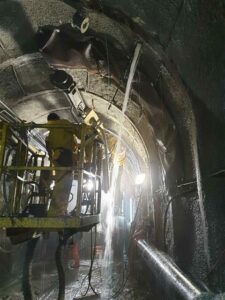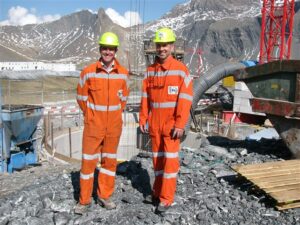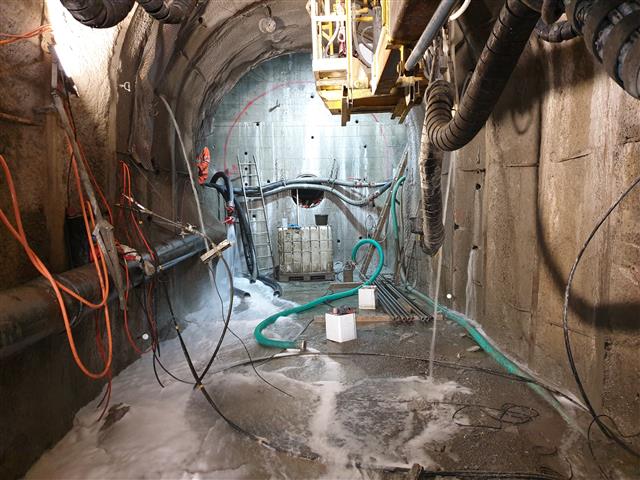Once again our well-known archenemy is trying to thwart our plans: water. We have already dedicated several blogs to this topic, for example to enlighten our readers about sealing measures in anhydrite-bearing mountains, or to get insight into dewatering methods from the Bronze Age to the present. Today’s blog entry we dedicate to a current innovation in injection technology, namely hybrid injections. These combine the advantages of two well-known injection methods to effectively combat water ingress. To quote Miley Cyrus (who would have thought it would ever come to that): “You get the best of both worlds!”
Andreas Heizmann, CEO of Renesco – Marti Geotechnik, knows that anyone who tries to fill in crevices is in dire straits with the ingress of water. If a pure cement suspension was used, it is simply washed out by running water. A seal with polyurethane resin is quite expensive on the other side. For this reason, Renesco has developed a new process with which cement suspensions can be combined with polyurethane resin (PU) injections as required. This way, water ingress can be stopped effectively and economically.
The problem
„In the past, you usually had to decide which injection agent to use before starting the injection process“, Heizmann explains. Depending on what conditions you then encounter, two types of problems can arise:
If you have chosen PU-material with a fast reaction time and then only encounter a small crevice with low water ingress, the injection agent cannot penetrate the crevice. “In this case, only the drill hole is filled”, says Heizmann.
Or if you chose a pure cement suspension or PU-material with slow reaction time and encounter a large crevice with high water ingress – in this case the material will simply be washed out.
The solution
In a new process, however, the two injection agents can now be mixed and their properties adjusted during the ongoing process. In two separate mixing processes both PU-components are mixed at first, followed by the mixing of the PU and the cement suspension. The properties of the mixture vary flexibly from “very fluid” to “very stiff”. The decision no longer has to be made in advance.

In practice the whole thing works as follows:
„By starting with a pure cement suspension, we first check whether there are only small gaps”, Heizmann explains. “If there is already an increase in pressure with this injection agent, an addition of PU would lead straight to a blockage and an immediate stop of the injection process. This would prevent the injection material from penetrating into the vicinity of the borehole. PU is therefore not added in this case. However, if there is a pressure increase with pure cement suspension, the PU will be added until a pressure decrease can be observed. The task is, in cooperation with the planner, to determine the applicable quantity specifications in order to achieve the desired spread of the injection material. If the addition is increased too quickly, it can happen that the spread stops too early.” Escapes of the injection material can be stopped by a short, strong increase in the PU resin, so that the injection process is possible without interruption.

For those how want to know what the exact process looks like, just click here for a short explanation video.
The addition of the PU resin can (but doesn’t have to) be done automatically. A “flow limit” of the cement suspension is defined for this, and PU is automatically added if the flow rate is higher. If the flow rate is lower, the addition of PU is automatically stopped in order to remain below the limit pressure specified by the planner. The flow of the two PU components is measured separately in order to monitor the correct mixture in a ratio of 1: 1. In the event of a deviation from this ratio, the pump operator is alerted.
Fun at work
The idea for this process is not exactly new, says Heizmann, but the machine and control technology, through which the addition can be set precisely and all essential values of the injection process can be recorded, is. The analysis and evaluation of the injection is done in eguana SCALES.

“The first experiences have been excellent”, says Heizmann, pleased about the success of the hybrid injections. „The machinery operators in particular enjoy how they can control the injection by adding PU. In the past, the injection process had to be aborted when injected material escaped, now the addition of PU is temporarily increased. The leakage usually quickly comes to a standstill. The addition of PU is then reduced back to the previous value and the injection process continues.“
Due to the increased injection success and the low dropout rate, costs can be reduced. Another advantage, so Heizmann, is the possibility to use local cement and imported PU for abroad injections. Because of the use of local construction materials, costs are kept low. “We believe that this is the ideal method to seal larger waterways and highly permeable layers of soil”, is Heizmann thinking about the future.
To close the loop, we end with a motivating citation:
There´s always gonna be another mountain, you´ll always gonna wanna make it move – Miley Cyrus, mining expert (The Climb)
*****
About Andreas Heizmann:
Just as water travels long distances, Heizmann has also travelled to the furthest corners of the world. For example when his work led him to Peru for two years, where he was in charge of a small irrigation project for those affected by a dam in the coastal desert. On the side he helped digging wells with his bare hands to a depth of 30 metres for small villages (As a result of this contact, over 25 wells with water storage and extraction have been created in Peru to date: “Here the water was not our enemy, instead the joy was great when we finally found it after weeks or months of work.”).
Or when he was project leader in 2006 in Vancouver and part of the erection of the Golden Ears Bridge with piles of 2.5 metres in diameter and lengths of up to 100 metres on land and in the river.
The civil engineer started his career with a degree in civil engineering at the technical university of Karlsruhe, where he decided to specialise at the institute of soil and rock mechanics. Since 2012 he is CEO at Renesco, department Marti Geotechnik.

Picture credits: Renesco/Marti Geotechnik
